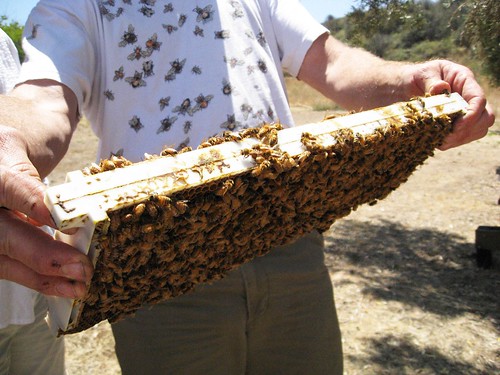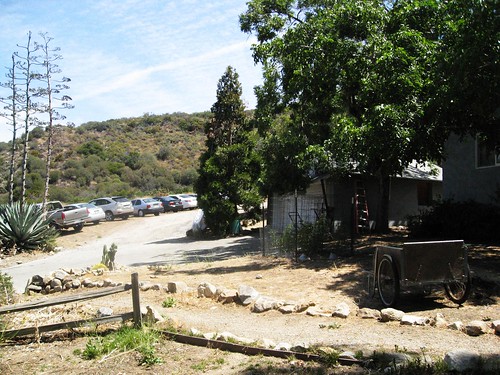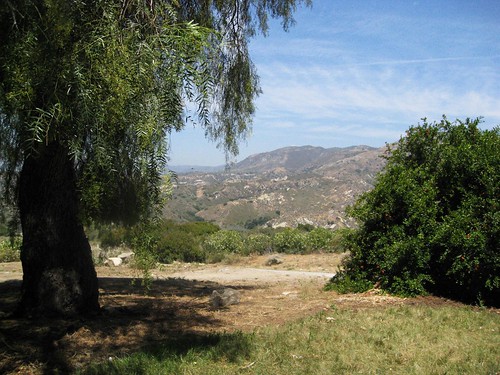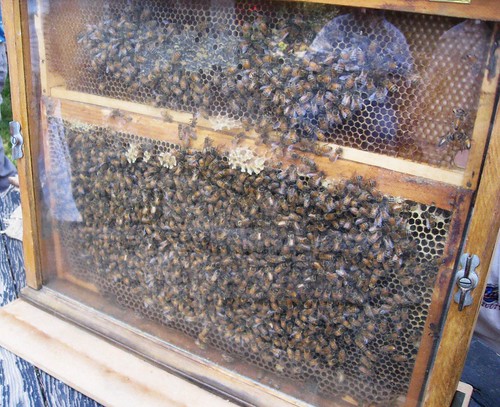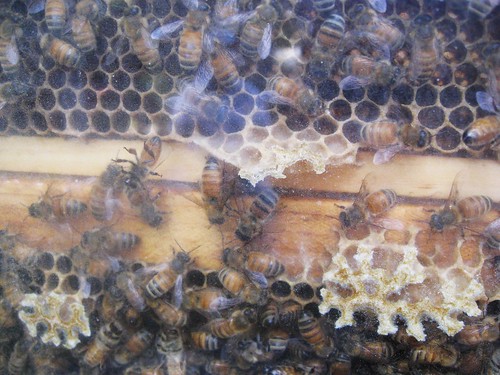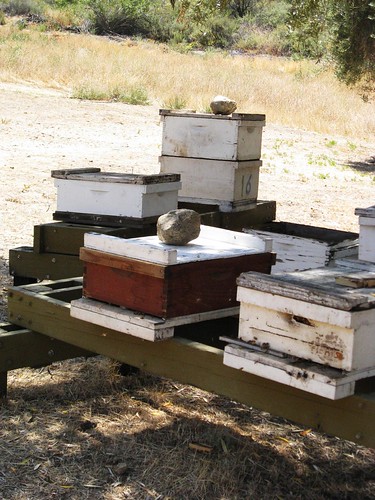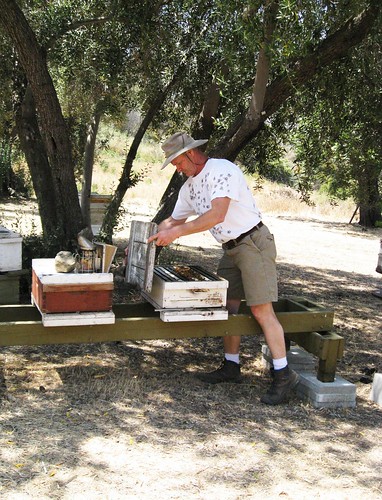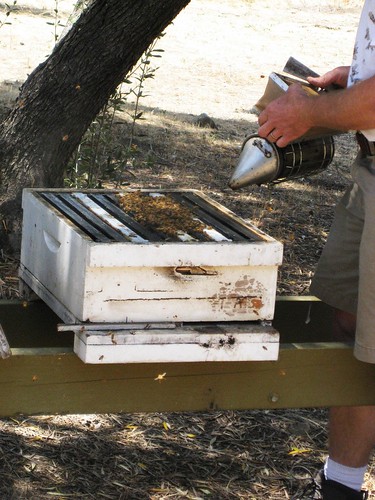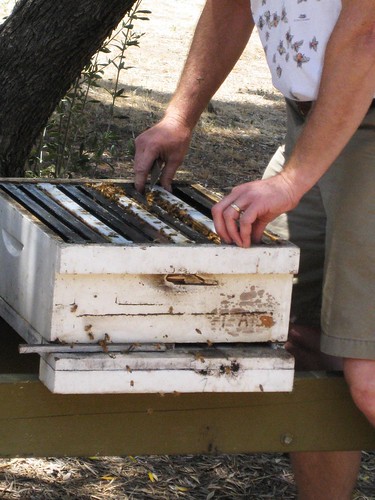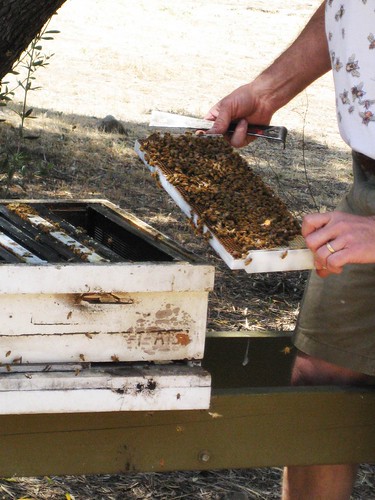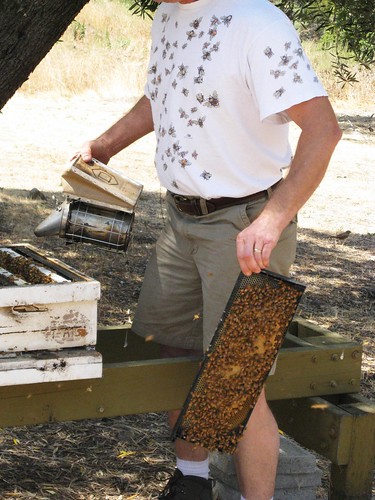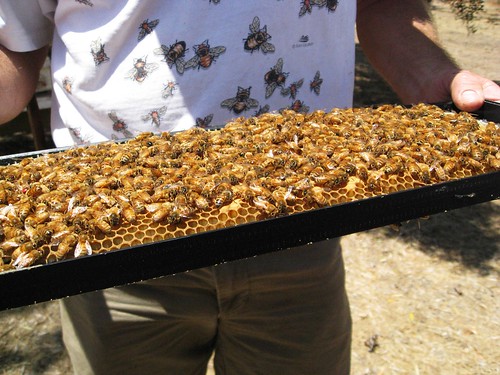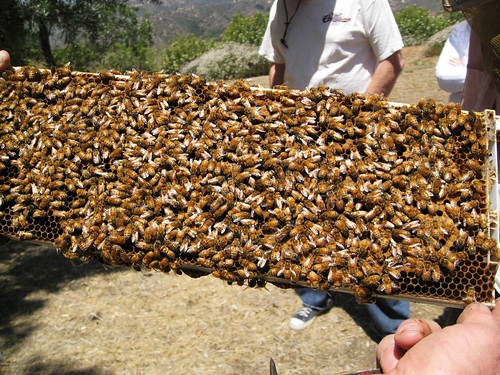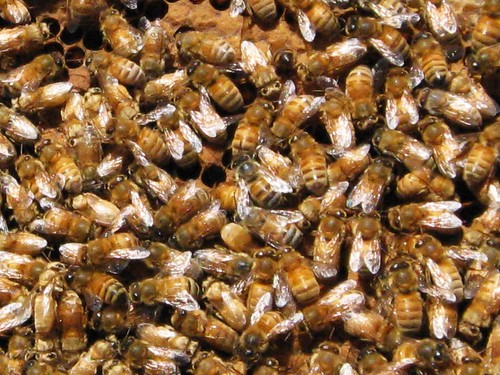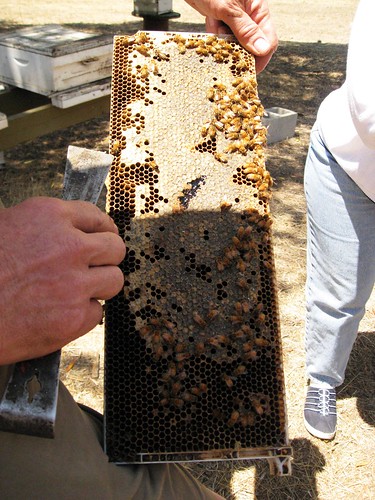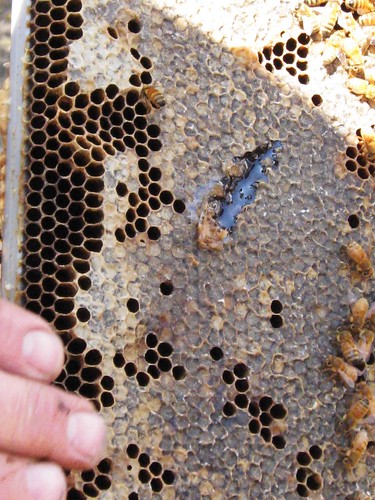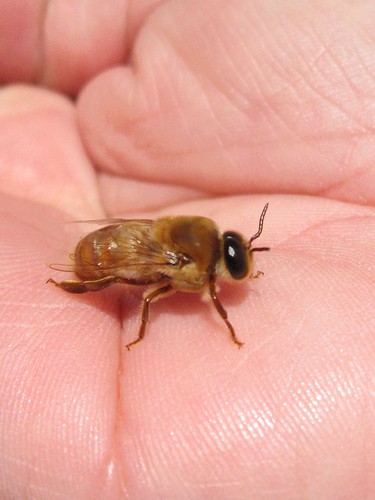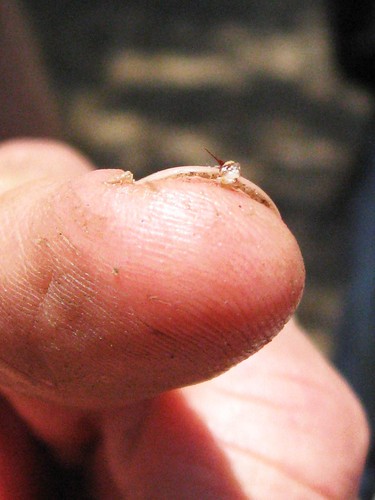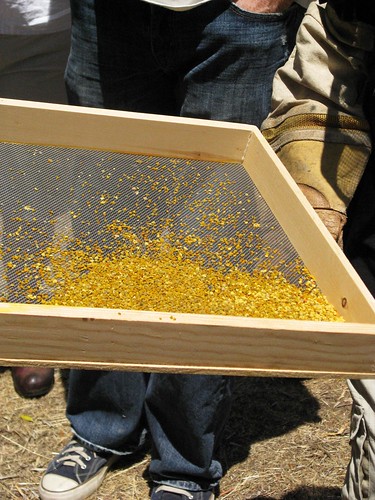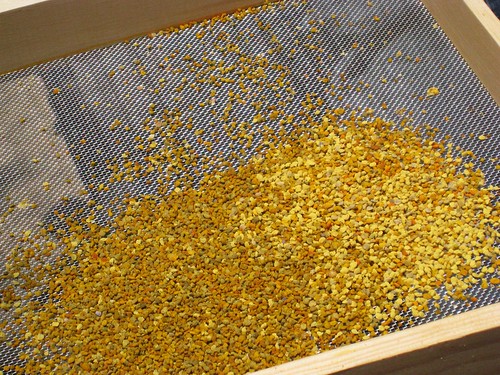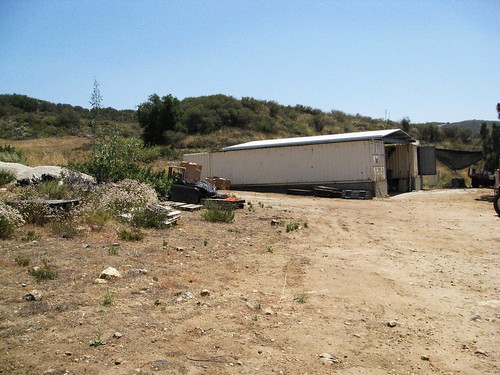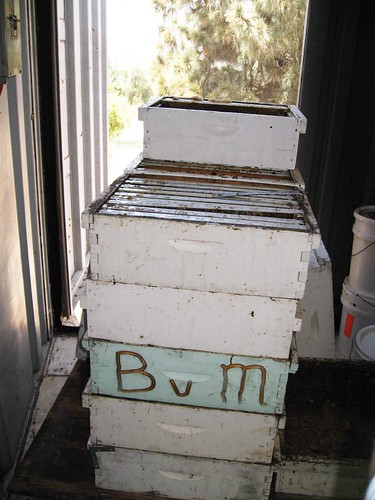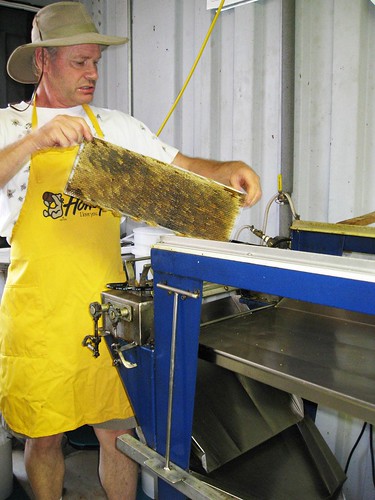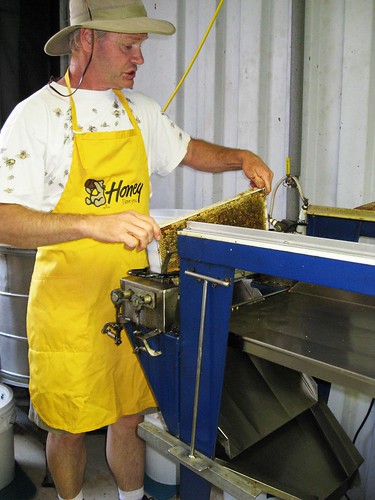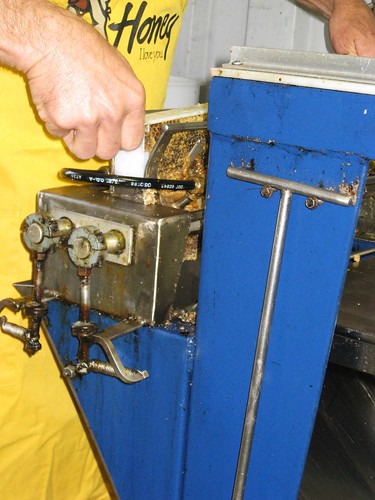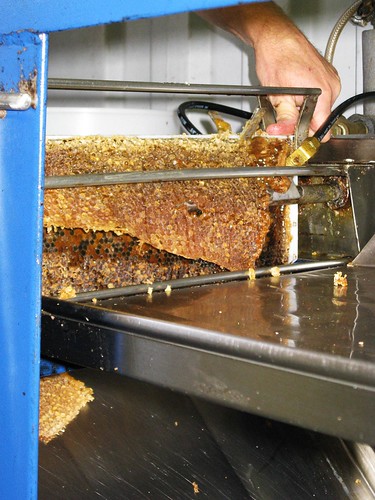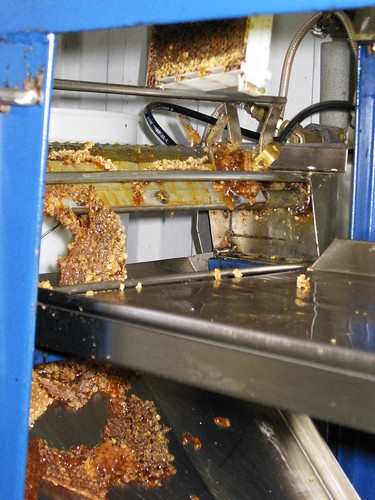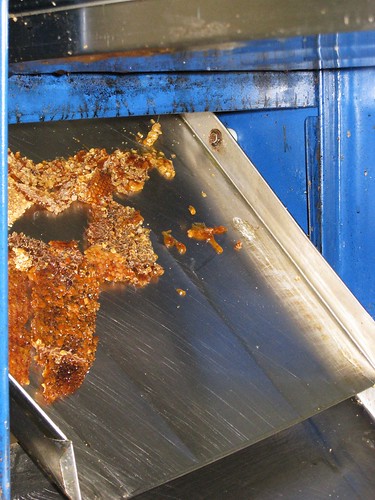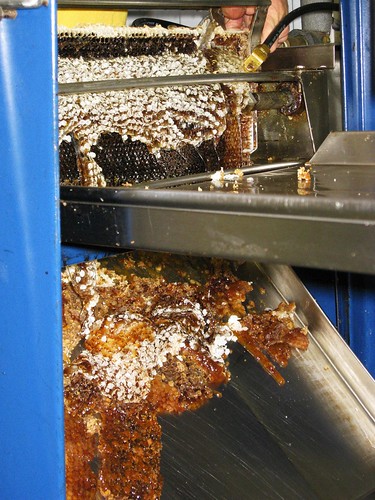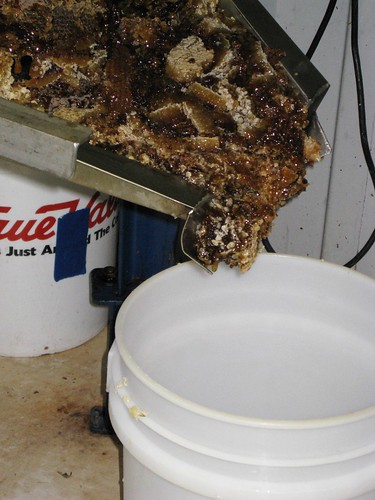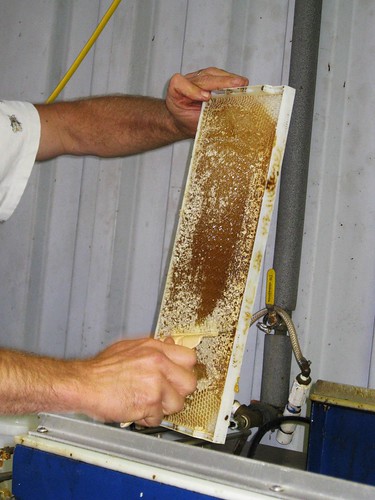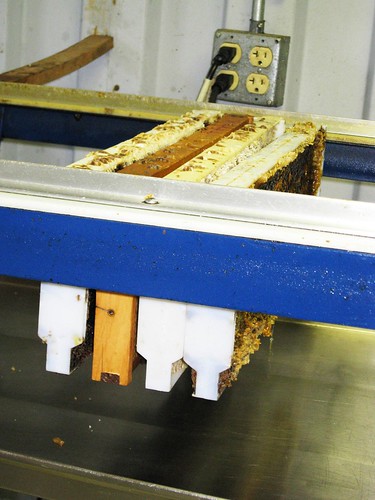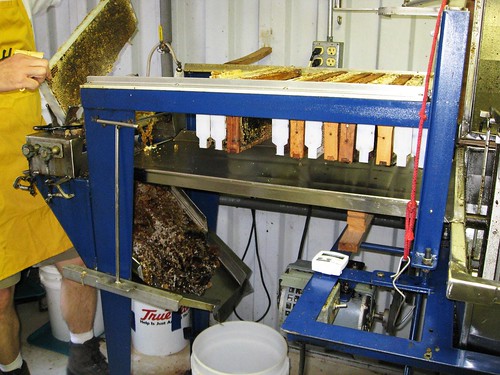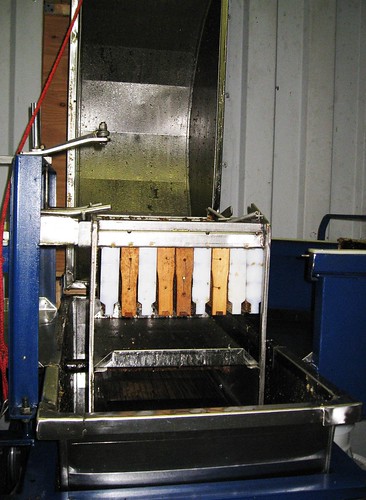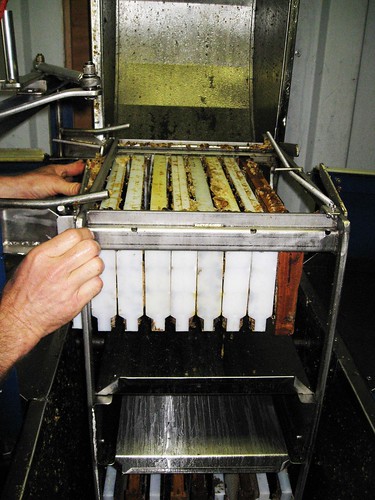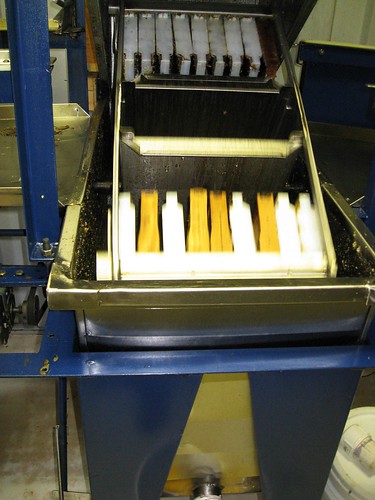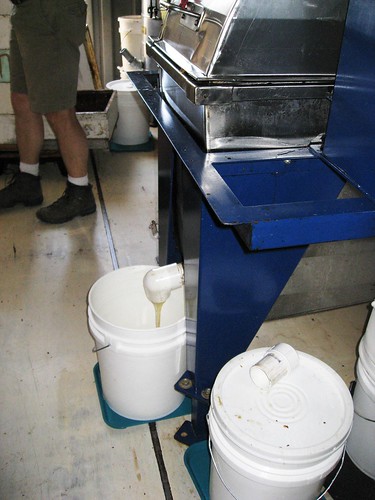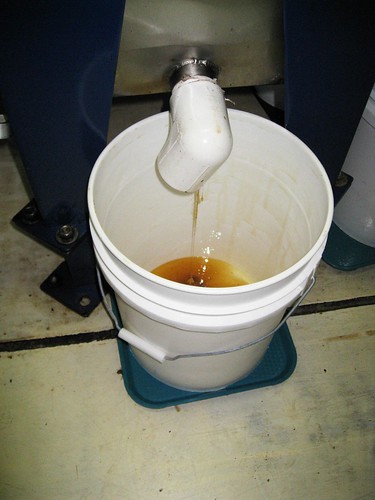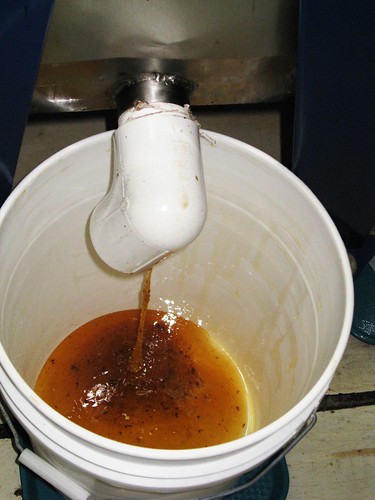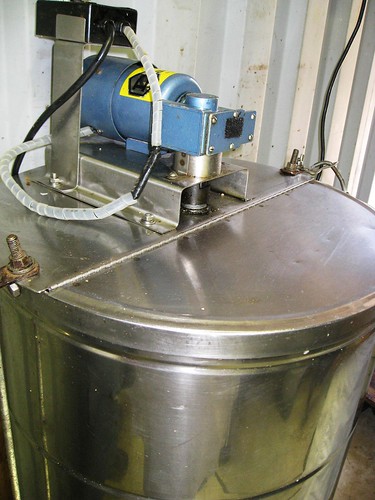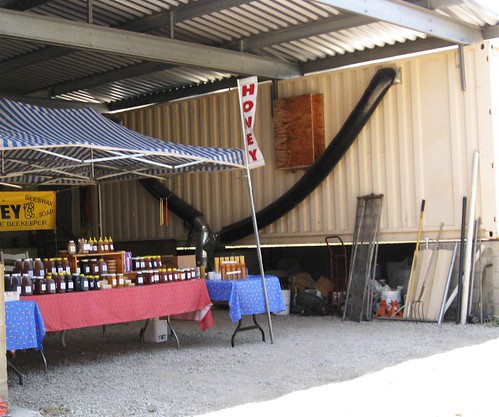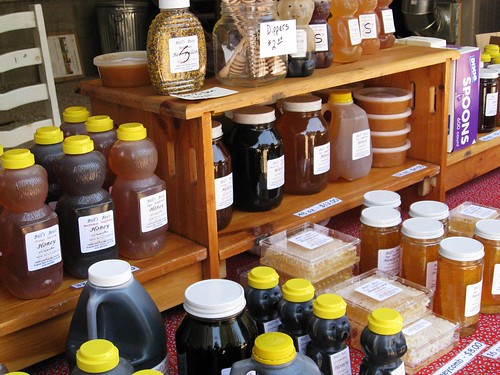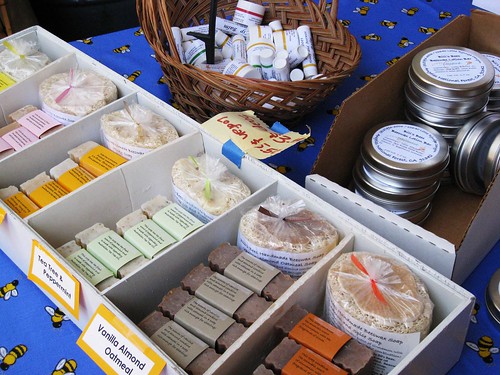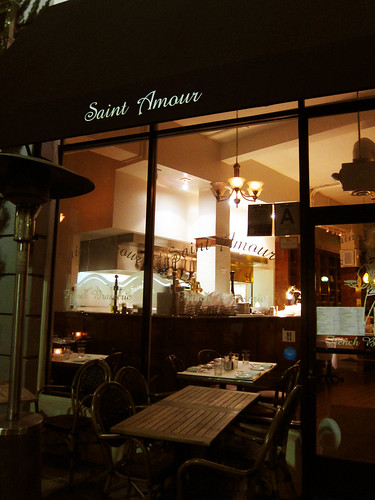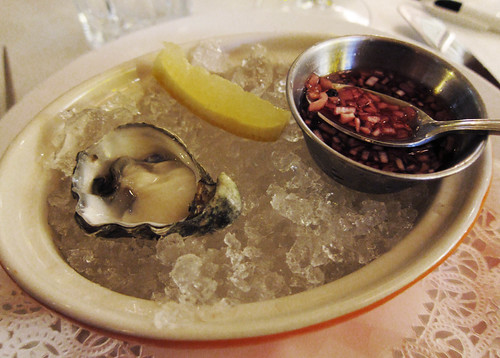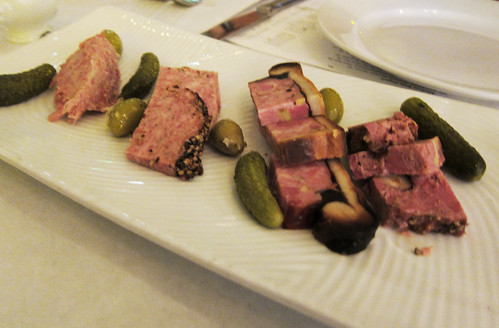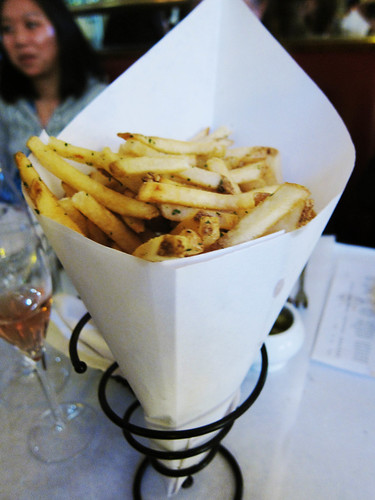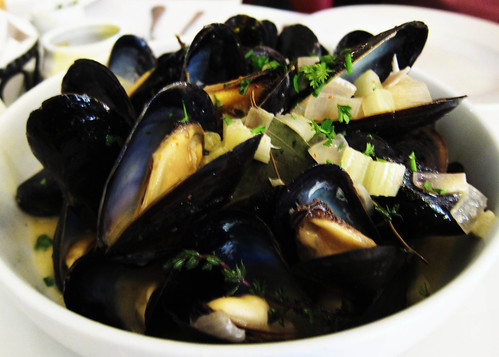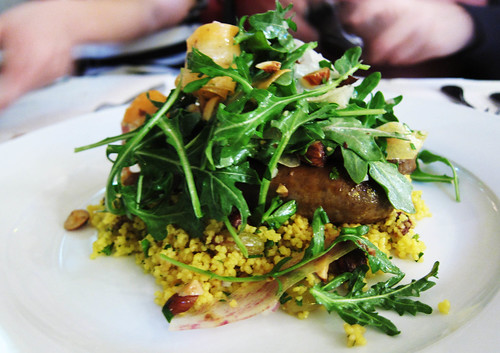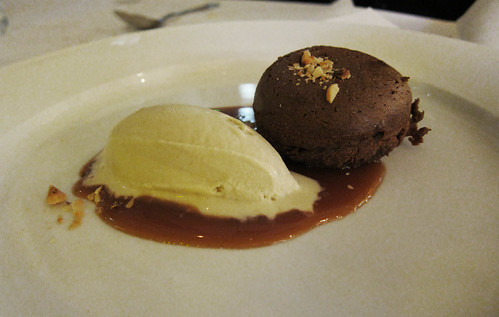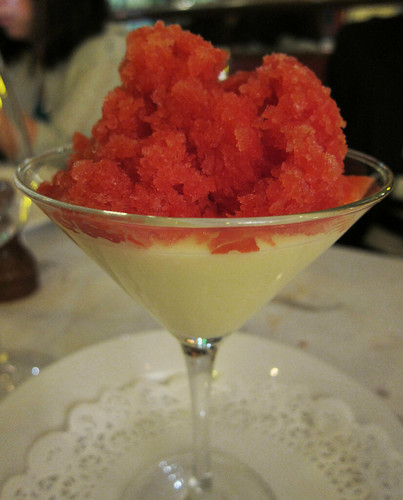In 2008, I set up a tour of Bill's Bee Ranch for my dining group and finally, the day arrived. Our education started as soon as we stepped onto the property of Bill's Bee Ranch. The first thing we learned from Beekeeper, William "Bill" Lewis" was that almost all the honey that he sells at various farmer's markets all over Los Angeles is homemade. Literally!
Bill's Bee Ranch, located in the Angeles National Forest, is the home of Bill and his family and they share it with the hundreds of bees he keeps in crated hives. Bill takes working from home very seriously. Most of the honey produced from his bees come from the nectar of flowers, plants and trees that are growing in the general vicinity. Another thing to note is that no pesticides or fertilizers are applied in the bees' gathering area, which makes for pure, raw and natural honey. Also onsite are the equipment he needs to extract and manufacture his artisanal honey products.
More ...
After that little intro, we were able to view a working hide from an enclosed glass stand. It was really interesting to be almost nose to nose, at least from behind the glass, to all the bee activity happening in front of our eyes. As we watched the bees hard at work, Bill gave us more bee facts like the following.
The Cells Know: While the cells in the hive do contain the honey, they are also where the Queen Bee lays her eggs. The way the cells are capped determine what kind of bee will be born. These coverings or "cappings" over the larvae are porous so that developing larva and baby bees can breath. It is made of a combination of beeswax and gummy resins that bees gathering from bees. Cells with flat cappings contain worker bees. Cells that protrude and look more bullet shaped will be drones. Cells that hang from the bottom of the frames or between honeycombs and look like peanut shells will be Queens. Cells filled with honey are capped with beeswax and are non-porous like sealing it in a jar.
Only the Best for Royalty: While all baby bees are fed a little bit of royal jelly, the baby bees destined to be Queens are fed exclusively royal jelly. Royal jelly is a secretion from the hypopharyngnel glands in the heads of the younger worker bees. Worker bees on the other hand are transitioned primarily from a combination of pollen and honey.
Longer Lives the Queen: Queens can live from 3 to 5 years. They are most productive in terms of egg laying their first couple of years. Worker bees live between 6 weeks and 6 months. When they are flying a lot gathering nectar, their wings wear out quickly and then they'll only live 6 weeks. During the winter months, they spend more time in the hive, so will live closer to 6 months. The drones' soul purpose in life is to mate with a queen, if they are lucky, and then they die. Otherwise, they are pushed out of the hive by their sisters to starve to death in the winter.
The Life of the Queen: While queens live longer than the rest of colony, eventually, their time is up. There are instances where both mother and daughter queen bees are laying eggs side by side; however, since younger queens are more productive, worker bees will eventually stop feeding the dowager queen bee and the new queen bee will take over. If two virgin queens hatch at the same time, they will fight to the death. En garde! Also, the 1st new queen bee to hatch will seek out other unhatched queens and kill them by stinging them through their queen cells. Sisterhood doesn't count for much in bee world.
Interesting stuff, so far, don't you think? After giving us all this great info, Bill gave us a demonstration on how he uses a tool called a bee smoker and bellows to smoke the bees out of their hives, which is how their honey is collected. First, he smoked the bees out of the glass stand that we were looking at and than from a couple of his actual hives. The hives themselves are boxes with tray inserts hanging into the box.
One thing that Bill emphasized that the way to interact with a bee is simply to not make any sudden movements. Move slowly or keep still until they leave you. Batting them away just freaks them out and that's usually when you get stung. By the way, I mention this tidbit because for the next part of our tour, some of us really got up close and personal with the bees.
As mentioned, Bill smoked the bees out of a couple of his actual hives. It is on the surface of these tray inserts inside the box that the bees construct their honeycomb, a mass of hexagonal wax cells built by the bees to store their honey, pollen and baby bees. While he did smoke the majority of the bees away, the tray insert Bill pulled out to show us was buzzing with activity.
Some of the group watched from afar, but most of us took Bill's advice to heart and just quietly stood by to take a look. Along with the bees, we got a closer look at the honeycomb itself and when Bill scraped some of the capping off, we could see the honey below the surface. He even managed to cup a drone bee on his palm. No worries here. Drone bees don't have stingers, just the worker bees; however, he did actually get stung a little later. Such is the hazard of being a beekeeper.
Another thing that Bill pulled out of the hive was a pollen tray. Basically, along with the nectar from flowers and the plants, bees also collect pollen on their legs and other parts of their body and what isn't used to pollinate is brought back to the hive. Just like honey, the pollen is consumed by the bees, with honey being the carbohydrate and the pollen being the protein. Apparently, this pollen is also considered really good for us and many refer to pollen as a "superfood." In fact, you can even purchase it from Bill or other health food stores. To find out more about the benefits of pollen, click here. After visiting with the bees, it was now time for us to see how the honey is extracted.
Bill took us to a building in the back of his home, where a small group at a time was brought into his extractor and processing room.
After a more aggressive smoking so that the majority of bees are out of the hive, the hives are brought into this room.
Bill then proceeds to remove the tray inserts and uses a machine to scrape off as much of the wax as possible, with the wax going into a bucket.
What the machine can't scrape off, Bill will do manually. As the inserts are removed of their wax, they hang like soldiers in a row ready for the next step.
Once the rest of the wax is scraped off, the tray inserts are placed into a machine and once the door shuts, the trays are flipped round and round.
The honey is forced out of the cells because of that repeated motion or specifically, a centrifugal force and then drains to the bottom of this machine. Eventually the honey comes out of a faucet into a bucket, which Bill takes it to another machine for filtering. As for the wax, it doesn't go to waste. Bill's wife uses it to make everything from soaps to candles.
After seeing all the steps taken into producing honey for our consumption, we finally got to sample the fruits of their labor, both Bill's and his bees.
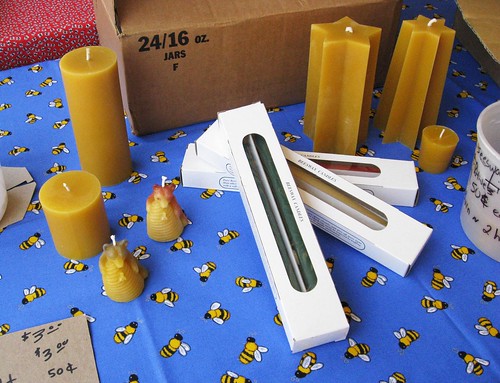
Overall, it was an awesome outing. Bill really knew his stuff and was happy answer any questions and share any knowledge he had. Now when I put a little bit of honey in my tea or spread it on a scone, I'm just so much more appreciative of the work that went into having it in a jar on my pantry shelf. Honestly, seeing specifically where Bill's Honey comes from makes me want to support local artisan food makers even more. It was so easy to see how much Bill loves what he does and the care he puts into his bees and his product really showed through. So if you happen to see Bill's Honey at your local farmer's market, be sure to stop by and bring some home. You'll definitely get quality product from a quality beekeeper and his company.
More Bee Tidbits
The Nose Knows: Bees are attracted to lemon and/or citrus scents because their Queens emit a lemon like scent; however, they shy away from bananas because the alarm pheremone that gets released when there's danger to the hive smells like bananas.
Deliciously Tasty: The honeycomb is edible because the wax is made from honey.
Just One Sip Please: Bees like to hang out at watering spots like swimming pools and if one happens to land on you, don't fret, they just want to get a refreshing sip of water off your skin.
You Complete Me: The only way that almonds can be in existence is if bees are there to pollinate them. Without bees, we don't have almonds. Interestingly enough, the honey made from almonds is bitter and unedible. This relationship is so important that almond farmers will actually rent the use of hives to ensure an almond harvest.
Storing Your Honey: Honey is a natural preservative because of its high sugar content. Too much water in honey will make it ferment. With the right yeast, fermented honey is "Mead" or honey wine. It's best to store honey at room temperature in a sealed container. In an open container, honey will absorb moisture from the air because it's a natural humectant. Cold temperatures will not affect honey; however, temperatures above 110F will start to destroy the honey's live enzymes, darken its color and changes its flavor.
The Nose Knows: Bees are attracted to lemon and/or citrus scents because their Queens emit a lemon like scent; however, they shy away from bananas because the alarm pheremone that gets released when there's danger to the hive smells like bananas.
Deliciously Tasty: The honeycomb is edible because the wax is made from honey.
Just One Sip Please: Bees like to hang out at watering spots like swimming pools and if one happens to land on you, don't fret, they just want to get a refreshing sip of water off your skin.
You Complete Me: The only way that almonds can be in existence is if bees are there to pollinate them. Without bees, we don't have almonds. Interestingly enough, the honey made from almonds is bitter and unedible. This relationship is so important that almond farmers will actually rent the use of hives to ensure an almond harvest.
Storing Your Honey: Honey is a natural preservative because of its high sugar content. Too much water in honey will make it ferment. With the right yeast, fermented honey is "Mead" or honey wine. It's best to store honey at room temperature in a sealed container. In an open container, honey will absorb moisture from the air because it's a natural humectant. Cold temperatures will not affect honey; however, temperatures above 110F will start to destroy the honey's live enzymes, darken its color and changes its flavor.
You can purchase Bill's Honey at:
South Pasadena Farmers Market
Located on Meridian where it intersects Mission
Every Thursday 4-8pm; except Jan. & Feb. 4-7pm
Santa Monica Farmers Market
Located on Arizona St. where it intersects 3rd St.
Every Saturday 8:30a-1p
Montrose Farmers Market
Located on Honolulu St. at Oceanview Blvd.
Every Sunday 9-2p
Sierra Madre Farmers Market
Located at Mariposa Ave. & S. Baldwin Ave.
Wednesdays 3-7p
Northridge Farmers Market
Located at Northridge Mall off Tampa
every other Wednesday from April-Oct., 5-9p starting July 30
To see all the pics, go to:
http://www.flickr.com/photos/la_addict/sets/72157607049254362/
Click here if you'd like to join Pleasure Palate for a Bill's Bees Tour on May 15.
^

